| Introduction |
Many years ago, in one of my first attempts to get students to make contact with email partners across the world Annie, a 26 year old ESL student from China, poised to write, turned to me and asked, "Is this writing or talking? The magic of that moment has stayed with me. She had sensed a dilemma that many others in years to come would try to analyse. What is it about this strange new medium that makes us feel that we are in new territory? In answer to Annie's question, others have more recently argued that is it neither writing or talking, but rather spoken writing, or written speech.
Many years later I was struck by the hesitancy of a friend and colleague who was an experienced and successful teacher. He was for the first time about to engage in an online forum with staff and students he had never met, and he didn't know how to do it. At that same point in my life I hadn't given it a thought. I had just plunged on in, but my colleague had questions:
- what do I write?
- how much do I write?
- do I make it personal? how personal?
- what tone do I use?
- do I ask questions?
All legitimate questions of course, but it was moments like these that made me realise experienced teaching professionals need to learn how to do this 'online communication' thing. It does not come naturally to everyone. He dithered for a few days and eventually posted this as his first contribution to the forum:
"here's a puzzle for us all:
why would we call the discussion topic 'trans pacific 4913812334'?
hello.
i'll start contributing from now on.
John"
I winced slightly when I saw it, and wondered what those on the receiving end may make of it. Why isn't this a suitable opening? (The good news is that there was someone on the other end of the world on his wavelength and solved his problem and all was well!)
But John had unwittingly slipped right into some of the conventions (or lack of) that characterise much online writing - a disregard for conventions of grammar. He had instinctively opted to omit punctuation and capitals. Did he sense somehow the lower level of formality required?
Annie and John's hesitation to dive headlong into online communication is in part because we are in effect dealing with new genres of written expression, and they have different rules.
Before we look further at this concept of genre, let me quote from a forum user:
"It seems to me that though most people on campus have learned how to use email and/or bulletin boards, few have gained "excellent communication skills" in those media. When one does not have body language, facial expression, tone of voice or pauses/silence/lack of comment, it is often hard to be sure one understands/is understood." (from the third annual WebCT users pre-conference forums, June 2001)
| A NEW GENRE? |
A standard dictionary of GENRE offers simply "a literary species", OR "a particular style, esp. of literature, art, music, etc., recognizable by its particular subject or form". Suffice to say that in verbal communication, and in writing conventions therefore, there are rules that govern that form, and how one writes. We learn these rules as we grow, at school, and from observation and practice. We know how to write letters, formal and informal, notes to housemates, job applications, and other assorted forms of written communication.
Most of what we wrote pre-Internet days was also essentially private in nature. Most writing for most people is one to one. What we write mostly is not intended to become a public document. The Net changes all this. Anything one writes, even personal email, can become public domain. Letters could also be shared in the past but not with such immediacy. A private email can be inadvertently, or deliberately, shot across the web to a huge unintended audience in a matter of seconds - and it has happened.
We will return later to how these new forms of written communication have resulted in a range of conventions in these new genres, but one last point here:
|
70% of all
human communication is non-verbal
|
(if anyone knows the source of this much overused statement please advise!)
The lack of non-verbals in much online communication provides a clue as to why people feel a need to develop other strategies (conventions) to compensate. They need other props, such as emoticons :), (: to do the job that eyes, face and hands do in face to face communication.
| SCOPE OF THIS PAPER |
This paper will focus on:
- Emoderation as a process of managing online communication
- It will not include all aspects of online teaching (setting assignments, marking, etc)
- particular focus on the language that is used, as well as the role of the Emoderator
- this process is not just the role of the teacher/facilitator - eModeration is incumbent on all participants
This paper is more the result of action learning (learning on the run). A recent debate on a listserv yielded the following comment:
I've learned many useful things from what has been shared, but everything I've benefited from was another educator sharing his or her personal experience. That experience *may* have been grounded in published research, or it may have come from what I would call "personal research"--"I think this will work, let's try it and see, then evaluate and make changes." But bottom line, I don't want to be pointed to a list of books or articles to read when I have a question, I want to know what worked in someone's classroom. It's not that I'm anti-research; it's mostly that I don't have time to find and read an article because I'm too busy teaching a heavy load. I need answers quickly.
(Dan Butcher, English Department, Southeastern Louisiana University)This is very much my position. I would love to take some time out to study but for now I'm too busy 'doing it", and the wonderful thing about the Internet, as Dan Butcher alludes to above, is that you have daily access to experts and practitioners in all fields.
| THE
BIG THREE - EMAIL, CHAT, FORUMS MODELS AND THEORIES |
I will focus on the 'big three' of online communication - email, chat, and forum - and examine the attributes of the language used in each, suggest some relevant issues and strategies for moderators for each 'media', and then briefly examine existing theorettical models that attempt to provide a structure for analysing online moderation. I will discuss the models and approaches of:
- Gilly Salmon (http://pcbs042.open.ac.uk/gilly/)
- Guy Bensusan (http://users.chariot.net.au/~michaelc/nw2001/esc.htm)
- Edward De Bono's Six Thinking Hats (http://www.sixhats.com/home.html)
| EMAIL - THE WORKHORSE OF THE INTERNET |
Email is now used more than the telephone in US business life. In many respects it is similar to letter writing. The level of formality however differs with context (known or unknown audience? cultural issues) One of my online students asked:
“Could I write "Hi teacher" at the beginning of my e-mails or would it be impolite?”
- Julian.
Email is the most personal of the asynchronous media in its basic form, but is often shared among many and hence becomes a public document. The growth of email lists such as yahoogroups.com, and interest based listservs have been instrumental in this process. Like all writing in the electronic media there are no physical cues, so when you get this:
Michael,
You wouldn't happen to know where my personal copy of Office that I loaned to you last week would be?
I would appreciate it back ASAP!
Thank you!
it is singularly abrupt. There is nothing to cushion you from the naked words, which here are terse, direct, and sarcastic. Even the thank you seems like an order or a dig. If I did not know this person I would be forgiven for being affronted, and assume they are quite rude. The lack of physical cues and the typical reduction of words to all but the bare essentials that characterises the email style of many leaves me with a bald and pushy message. Contrast this message with the following:
Hi Michael
Can you please add Sally Pearce to the IDEA? Her Global ID is something like s000182 (she left something out when writing it).
Her email is pearces@regency.tafe.sa.edu.au
Cheers
Best regards
David Benton
Instructional Designer & Lecturer
This too is a short and to-the-point email, but the use of 'please' and pleasant leave taking ('cheers', and 'best regards' in the signature) softens it and leaves the impressssion that this email has been sent by a warm and considerate emailer! This may sound obvious, but remember we are talking about a context where the two parties of the conversation may not ever meet, and you do leave an impression, whatever you write, so you may as well leave a good one!
It IS easy to cause offence writing online. From an email discussion list:
A: I wonder whether I have unintentionally caused offence? It seems easy to do this here, which would certainly end my participation.
B: Oh please no. It is too easy to become offended in email, everyone should realize this. it is also easier than you think to become offensive in email.
| EMAIL - level of formality |
The level of formality in email governs, and is governed by, things such as greetings and leave taking, and the use of signatures Greetings can range from
- Hi
- Dear John,
- Margaret -
- or nothing at all!
Leave taking presents a similar range:
- thanks,
- cheers,
- cya,
- regards,
- best wishes,
- yours sincerely,
I have a range of signatures all of which I use as appropriate:
- M.
- Michael C.
- Michael Coghlan.
or the whole works:
- Michael Coghlan
Professional Development Officer
Online Education Services
TAFE SA
email michaelc@tafe.sa.edu.au
Tel 0417 8999 12
How you make use of all these conventions may not seem very important in the overall scheme of things, but each choice you make will reveal something about you in a world where people may have no visual information about you, so if you use no greeting and a simple 'cya' in an email to a teacher explaining why you have not been participating in the forums lately you may be creating the wrong impression! Likewise, letters to friends that have the same standard greeting, leave taking and full signature every time *may* leave them thinking you don't individualise the message enough......
| EMAIL - layout |
When we see something like this:
|
56 Findon Ave Dear Sir/Madam, On the 28th July, 2000 we had a party for my son's birthday. We noticed in the days after the party that my son's Sony Walkman was missing. We were not sure it had been stolen, and thought it might turn up somewhere in the house. We never found the Walkman and a few weeks ago a friend of my son said that he knew where it was and confirmed that it had in fact been stolen. I rang Mutual Community and explained the situation to them and they said that the theft of this item would be covered by our House and Contents insurance if 1) we reported the theft
to the police, and We have since reported the incident to the police (see copy enclosed), and I also enclose a receipt for the original purchase of the Walkman. Yours faithfully, Michael Coghlan. |
we know instantly what it is. We have learned from school and observation that this format (shape) represents a letter. And when we compose a letter we automatically know how to lay it out. Email has a different 'shape', and it has its own conventions that must be learned if you are be an effective communicator in the medium.
Tips:
- use a subject line
- don't put more than a few names in the cc, or bcc fields.
- delete all the garbage at the the top of a message if you are sending someone a message that has already been forwarded on many times
- use inline comments like this:
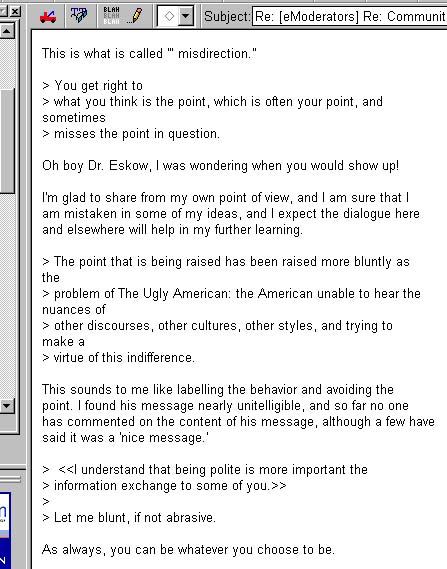
| EMAIL - punctuation |
Examine:
“a teacher does not have to be both hard AND inhumane ... some of the best teachers i remember were those who insisted that i did more ... and they did their best to help me understand WHY this was important ... and they were compassionate about it to me ... and passionate about it too”
(dennis from DEOS)
Clearly Dennis, and John seen earlier, both experienced professionals, have decided that capitals and punctuation are dispensable in the email world. Perhaps it is simply that it's quicker? Perhaps they want to convey the fact that it is more informal than other earlier forms of written discourse......one should ask them......
| EMAIL - eModerator's Role? |
Much of this may seem to have more to do with mechanics rather than the process of communication. Does the eModerator have a role here, especially in view of the fact that much email is one on one? I believe so. The emoderator's role is both practical and pedagogical here. It IS a new language with new conventions; these conventions need to be recognised, taught, and made explicit. In email it is essentially one on one guidance unless it’s a group email list, then the same rules apply as forums. And therer we will have more to do with the process of managing true communication online
| FORUMS, BULLETIN BOARDS, DISCUSSIONS (“The guts of online educational events”) |
Imagine knowing nothing of online forums and being confronted by something like this on first entry!

Online forums are the most formal of the 'big three', and their defining feature is that they are public in nature. They have been spawned by the Internet and are designed as a many to many style of communication. They are more suited to high level discussion due to their asynchronous nature, and often use the discourse of debate. This makes them a daunting prospect for some and any text you contribute is left there for all to see. You cannot bring it back once it is posted. Unlike email, forums are removed - you need to go to the next room to take part. It is a considered action to go and take part. BUT, they can be used at every stage of an online experience.
Let us now consider Gilly Salmon’s five stage model*, and see how it can contain the various stages of online interactions. (* from E-Moderating - the Key to Teaching and Learning OnLine, Kogan Page, 2000)
| Gilly Salmon's 5 Stage CMC Model |
Gilly Salmon's 5 stage model of CMC (computer mediated communciation) outlines the various stages online participants typically proceed through in online events (what she calls e-tivities). The purpose and nature of the communication for each of these stages is quite different . Generally speaking the level of discourse required for each stage grows more complex as you progress through the five stages.
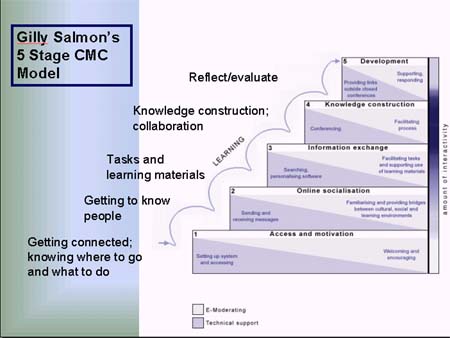
(for more detailed explanation see http://www.itlc.life.ku.dk/it_paedagogik/elaerings_paedagogik/gilly.aspx)
To illustate the point see these two examples:
Stage 2 (familiarisation)
Hi! My name is Annette W and this is deffinately a new way of learning for me.
I'm not used to not seeing the people that I'm learning with in class. I'm looking forward to this new medium and hope you all feel the same. Hope to hear from you soon
Bye for now
Stage 4 (knowledge construction, collaboration)
“We see clusters of course development here, too. Some of this is can be the support services in place in the department, and some of it can be explained by the "Diffusion of Innovations" work by Everett Rogers.Rogers says that there are five interrelated attributes that accompany the diffusion of technology: its relative advantage when compared with other methods; its compatibility with the existing culture; its complexity of use; if it can be experienced in a limited way; and there is the ability to observe how others have used it. The clustering of faculty in one department or college speaks to the latter attribute. Part of the strategy we employ to enhance this effect is a series of "Showcases" at which faculty speak to faculty about their experiences.”
- Catherine G
You can see from these examples that there is a big jump in the level of discourse from stage 2 to 4. It is my experience of online teaching and learning that many never reach stage 4. Stage 4 exemplifies something of what is sometimes referred to as the paradigm shift apparent in online education. The Internet used this way asks participants to collaborate, create, and share knowledge. It does require a high level of literacy and many have never had to write like this with colleagues. This kind of written discourse may only have been employed in tertiary studies, and was subject to review and assessment by a lecturer only. Collaborative online courses, especially those of an academic nature, require this kind of communication to be scrutinised by peers and this, not surprisingly, can intimidate people at first.
Now we have another element of concern added to those expressed by my colleague (John) above - will my writing ability stand up out there under scrutiny from fellow participants? Will I be able to express myself clearly? Will I appear inadequate?
| Forums/Email - eModerator Strategies |
Some steps can, and should have been, taken to ease the potential embarassment of this stage:
- make sure everyone knows the mechanics of how to post (stage 1)
- make sure everyone knows and feels comfortable with each other (stage 2)
- establish some ground rules about etiquette, manner, and respect for others and their opinions (stage 2)
- give some guidelines about the length and frequency of posts (ie discourage lengthy, verbose posts)
- establish smaller groups so that people's opinions have a smaller audience
It becomes apparent then that Salmon's model, as well as been an effective tool for measuring and categorising the types of online interaction, becomes a necessary path to follow if participants are to feel successful at the more demanding tasks associated with stages 4 and 5.
Another model
By way of comparison, Morgen Flate Paulsen (Nettskolen, Norway) suggests another way of viewing the role of the emoderator. He says the role of the emoderator can be divided up into three functional areas:
- organisational
- functional
- social
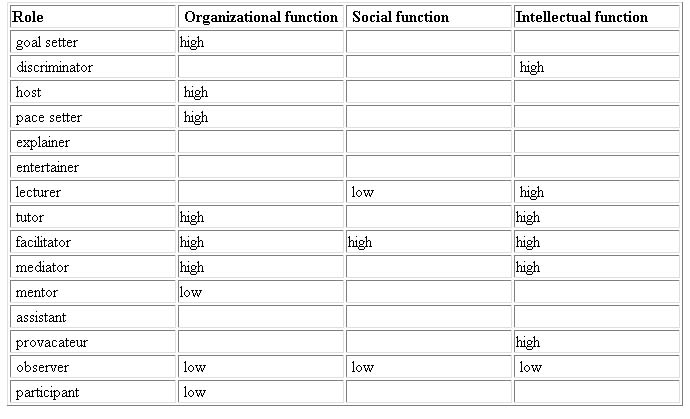
Published in Berge, Z. L. & Collins, M. P. (Eds.).(1995). Computer-mediated communication and the on-line classroom in Distance Education; on the web at http://www.emoderators.com/moderators/morten.html
Online Socialisation (stage 2)
As essential as online socialisation may be for some (or most) learners, there are some cautions to be aware of. It is common knowledge now that online students tend to get closer to their teachers, and fellow students, than happens in f2f classrooms. Something about being decorporealised/disembodied allows people to more freely express personal information than they do in classrooms. The up side of this is that people get to know each other really well. Ruth Geer, from the University of South Australia (see http://www.com.unisa.edu.au/cccc/papers/non_refereed/geer.htm), has identified a downside. She has found that some students over expose themselves and become vulnerable to attack from other students later in a course. She therefore warns her students to limit the level of self-disclosure.
However, this socialisation is a necessary stage for many. Socialization in f2f situations happens in defacto fashion between classes, in coffee breaks, and other random meetings on campus. These random meetings do not occur online and the socialisation needs to be arranged. This is best done using online chat, and we will examine that presently.
| FORUMS - More Issues/Strategies for Moderators |
Other issues to be addressed by moderators when using forums:
- Who starts discussions?
- How long do you let them go?
- How do you bring about closure?
- How do you deal with flaming? (private approach is always better)
- appoint co-moderators from participants and create sub-forums
- how long should individual posts be? (Model and Encourage concise postings)
- how often do people need to post?
- should forum participation be marked? (YES!)
- Model and Encourage inline replies
And in the light of recent international events:
| How do you deal with major events such as the bombing of the World Trade Center? Should they become the focus of ALL online discussion for a time? |  |
| HOW TO BE A BAD HOST! |
It may be useful to see your role as an emoderator as something akin to being an online host. You, as the host, can make or break the event for the party goers.
On the lighter side :) , try these strategies to ruin your online communications:
- Make sure everyone knows you're a host of the chat or message boards. It's good to let people know you have a power that they don't. It's even better if you throw your weight around with "I'm a host and you're not" attitude.
- don't ever greet a newcomer…. if you ignore them, they won't come back; that way, you won't have as much work to do.
- if you're hosting a chat, don't speak a word. Ignore the chatters if you can. The others in the room will respect you more if you don't join in the conversation.
- Learn how to focus all conversations, whether on chat or boards, on yourself. Don't be on time. Nobody cares if you show up for your topical chat on the Duck-billed Platypus. Heck, leave early even!
- make yourself as unavailable as possible except during those hours you're scheduled to work. Don't even read email during your non work hours.
- And of course, don't forget to put down and make fun of things that people post in your forum
| HOW TO BE A GOOD HOST! or WHAT A (good) ONLINE HOST WANTS TO ACHIEVE: |
- the ongoing goal is civil discourse: all kinds of people having conversations and arguments about a variety of subjects and treating each other decently.
- authentic conversations -- from the head, the heart, and the gut.
- a feeling of ownership. Participants become evangelists.
- a spirit of group creativity, experimentation, exploration, good will.
- a shared commitment to work together toward better communication, better conversations. If this is achieved, nothing else is needed.
- a system where people figure out where the conversation is going, by themselves, and settle conflicts among themselves
( these tips courtesy of Howard Rheingold at http://www.emoderators.com/moderators/artonlinehost.html )
| THE MUCH MALIGNED WORLD OF ONLINE CHAT |
"Chat is the form of computer-mediated communication that most closely resembles spoken interaction. But in contrast to spoken interaction, chat is poor at managing interruptions, organizing turn-taking, conveying comprehension, and resolving floor control conflicts. Studies of chat from a variety of fields (including sociology, communication, CSCW, and HCI) share a focus on the challenges and ambiguities chat introduces into the normal mechanisms of social interaction. " (from Burkhalter at http://byronandgen.net/chatandconversation.htm)
Online chat is
- the most radical departure from previous communication methods
- it has spawned a host of conventions and protocols
- the most difficult to make work in an educational context for stages 3 and beyond
- synchronous (real time, and therefore the most like spoken conversation)
Multiple Jumbled Threads (chaos?):
<Maggi> see the positive in it
<Vance> How is your life a mess, YL? Aren't you excited about
going to New York?
<Maggi> How do you think you did Aum?
<ying> I lost my passion.
<aum> hmm i think i'll pass all except chemical :( i'm not
sure ,,i dont like chemical
<Vance> In a different, exciting city, you can get your passion
back
<Maggi> passion for what?
<Vance> chemistry? I thought you were in business.
<aum> ying .u r gonna go to new york?
Questions follow questions (chaos?):
Michael
C>>So karen - were you able
to achieve a diff
outcome with your client on Thurs? (as a
result of the T workshop?)
Karen H>>Pam, perhaps you could
frame that question in
terms of the ANTA, competency approach. "Will
this competency/outcome help this person in
the workplace?"
Answering 2 Questions at once (chaos?):
Michael C>>Sounds fine Karen. (Yes - true Pam!)
Humour in online chat (chaos?):
Anne D>>Hello
everyone
Elizabeth P>>Welcome Anne
Janette H>>Myself and Dr. Tom R are taking on the roles of
lead designers and project managers....
Maryanne H>>Hi Anne
Instructor >>Welcome Anne - we are talking about what Janete
is doing in Georgia
Pam B>>Hello Anne. How many whales did you see?
Instructor >>Well we were!
Janette H>>The others on the team are all instructional designers
and media developers -- creating the tools to go into the environments
Anne D>>I saw lots of whales- at least 8 to10 at any one
time.
Pam B>>How many of them have subject expertise?
| IS ONLINE CHAT CHAOTIC? (and does it matter if it is?) |
When people adjudge online chat as chaotic they do so because they find it difficult to cope with this new medium of communication. Specifically they refer to the lack of order on the way information is presented on screen, the lack of turn taking, and level of multitasking required to keep abreast of the conversation.
There are those that argue that online chat is a new medium that younger people are very adept at, and that it may well be a required skill in a new world.
- Teenagers can multitask (phone, chat, music, study)
- the first thing teenagers do when they log on is open instant messaging (private chat), but they maintain focus on other activities at the same time
- the multiple threads of online chat reflect to some degree transcripts of real conversations
- Yes it can be chaotic, but so is so f2f conversation. The difference is that these are TYPED conversations in real time
- still, chats needs to be heavily moderated if they are to function beyond stage 2 of Salmon’s model - socialisation
Moderated chat - positive reaction:
“I am still getting the hang of synchronous chats myself. (I am not a fast typer and I am slow to gather my thoughts) One thing that really seemed to help was a session of establishing ground rules and roles to give discussions more structure and having questions posted before the chats.” - Grad student, Instructional Technology
Moderated chat - alternative reaction:
Michael C>>What
if the facilitator was to get people to take turns?
Susan H>>how boring
Michael C>>Taking turns is boring?
Annette K>>We would probably have to sit for half an hour
and think what to say if we took it in turns
Susan H>>absolutely, so is standing in queues
Michael C>>So if turn taking is boring Sue what else do you
do to rty an impose some order here?
Michael C>>Shoild the facilitator impose order in online
chat?
Athalie M>>I guess it is not the role in this case for the
facilitator to rule. It seems to work more like a brainstorm session.
The facilitator may have a role of summing up the chat at the end if required
Athalie M>>I like the idea of the chat finding it's own rhythm,
Maybe we are creating a symphony! Or is it a rock band!
| MODERATING CHAT - some strategies: |
- Have specific focus/topic
- Turn taking
- assign roles (eg de Bono’s Six Hat Thinking)
- limit ‘hellos and goodbyes” - they break the flow of conversation
- employ the 'whispering' technique, but with caution - it can be considered impolite, and can cause some chat servers to slow down (whispering: communicating with one person in a group chat; usually done by highlighting that user's name and any text you type is seen only by that user)
- use CAPITALS to gain attention and focus the group; but again with caution, in some circles, use of capitals is considered to be the online equivalent of shouting, but chat centres can agree on their own protocols
- keep input short (5 - 6 lines maximum)
- 6-8 participants maximum; beyond this only very experienced users can cope
- use of …... to indicate that you have not finished......you can begin the next line with .......to indicate that you are following on from the previous line. This also addresses the problem if typing large chunks of text all at once
- address people by name - this combats the natural tendency of chat to multiple threads and lets users know who is addressing whom
- have a 'policy' on spelling (modelling mispellings is not a bad idea; it helps others relax about their own errors!)
- model and teach these conventions
- splinter groups into smaller configurations and retire to a separate chat room; return to main group for summary, or use in combination with forum or email for posting summaries
- have someone take on the technical questions if necessary - work in tandem with other facilitators (can be participants)
|
CHAT - use of emoticons
(: |
These are an accepted convention in most online chats (and many forums and group email lists). They are easily learned and save typing time! There are many websites that list the most common ones. One such site for emoticons is at http://www.computeruser.com/resources/dictionary/emoticons.html, and for abbreviations try http://www.computeruser.com/resources/dictionary/chat.html
|
ANOTHER MODEL - GUY BENSUSAN'S 6 STEP ESCALATOR |
An additional model for framing stages in the process of online communication is the method developed by the late Dr Guy Bensusuan from Northern Arizona University.

A full description of this model can be found HERE.
It is interesting to see how Salmon's and Bensusan's models intersect. Whereas Salmon's model appears to represent all the stages one may encounter in online communication, I would suggest that Bensusan's model starts at around stage 3 of Salmon's model - it does not deal with the access and familiarisation stages per se. But the Bensusan escalator model, if followed to the end actually takes participants beyond the reach of Salmon's model. The final stages of Bensusan's escalator are intended for those engaged in a fairly rigorous academic process of reflection and interpretation.
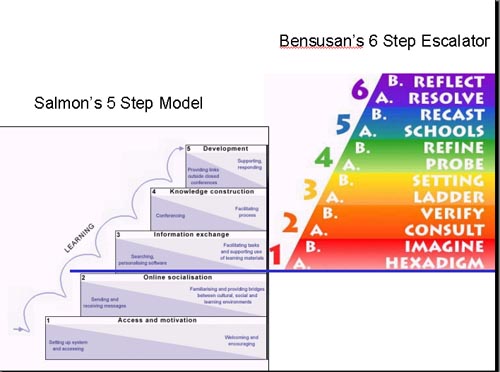
|
DE BONO'S SIX THINKING HATS |
A strategy that emoderators find useful in all forms of CMC is to assign roles to participants in accordance with Edward De Bono's Six Thinking Hats. Each hat represents a point of view or approach to a problem::
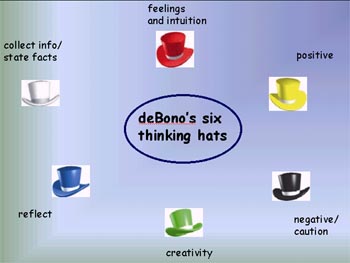
For a more complete description of these categories see http://www.sixhats.com/home.html
Now if we superimpose these thinking hats on the Salmon and Bensusan models we get something like this:
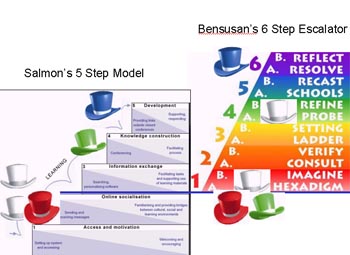
The thinking hats strategy can be used at several stages of CMC, as represented by these 2 models. As assigning a specific kind of hat means taking on a role it can be a very successful solution for those CMC participants who are uneasy about revealing too much of themselves in this new medium. Taking on a role assigned by a hat means they can participate in the dialogue and take some comfort in the fact that people will not be judging them as themselves.
| OTHER APPROACHES - Roleplay and Email Games |
Fablusi
The use of roleplay and email games as tools for the emoderator is really the topic of another presentation. There is currently (October, 2001) a LearnScope project underway that is piloting the use of custom designed software for online roleplay. More on the Fablusi (abbreviation of Fabulous Illusions) software can be found at http://www.fablusi.com For a report on the LearnScope project click HERE.
Email Games
Marie Jasinki from the Douglas Mawson Institute of Technology, who is also presenting at this conference, is currently engaged in writing a book on the use of email games as a CMC strategy with Sivasailam Thiagarajan (Thiagi). Many of these games also make use of strategies for disinvesting opinions from their owners. For more information on the Web go to http://thiagi.com
| CONCLUSION |
As Gilly Salmon suggests in the sub-title of her book, emoderating may well be the key to teaching and learning online. Focus has moved from content to process in online courses, and that shift of focus to process means that many online teachers will need to develop emoderation skills. In a very real sense, the skills of an emoderator are the same as a good classroom teacher when managing f2f discussions: listen, ensure that all have their say, guard against dominators, encourage respect for different opinions while encouraging people to challenge their beliefs, resolve disputes, bring discussions to meaningful closure, etc. As with so many other aspects of teaching, Internet teaching has not changed basic principles, but it has made educators collectively refocus on what constitutes good teaching. What works well in the classroom does tend to work well online. The big difference is of course you can't see your students online, and you have to learn new tricks to become a skilled online facilitator, but the guiding principles are the same. The 'tricks' (skills) though do need to be taught. Good classroom facilitators may know instinctively what works on or offline, but we cannot assume they will know how to apply their skills online. They need to see models of emoderation in action - they need to see HOW an emoderator copes with a racist student for example. They need to see HOW online chat can used for different purposes - social, transactional, brainstorming, academic........
Are we dealing with a new genre of writing? I think so. There is sufficient evidence to support the fact that there now exists at least two new writing genres - chat, and email. Both chat and email plainly exhibit characteristics that we have not seen in written discourse before, and they feel different - part writing, part speaking. I am less sure about the discourse typical of online forums. I think those who revel in forums do so because they are experienced in written academic debate. Their asynchronous aspect, and the consequently considered nature of much of the writing in forums renders can render them loquacious, verbose, and eloquent. But I have had little first hand experience in forums where true collaborative learning in a constructivist context is both the goal and the modus operandi. If anyone has any thoughts on this issue I would appreciate hearing them. (michaelc@chariot.net.au)
How useful are existing models for examing the process of emoderation? The Salmon model is comprehensive in that it caters for all levels of CMC, and affords the emoderator with some clues about the type of discourse to be involved in at each level. As students move through from access (stage 1) to critical thinking (stage 5) the emoderator's communication with them will change in tone and content, and it may be that you have learners who are at different stages within the same class. Salmon's model does make explicit the kinds of emoderation strategies that need to be employed at each stage (You would not congratulate someone who has summarised two weeks worth of colleague's postings for finding the right forum for example! In stage one though, it is important that you do offer such encouragement.
To be fair, the Bensusan model was not designed to explain the process of CMC. It was designed as a framework of higher order learning that is learner centred, and as such is really a manual for a more rarefied style of online communication that is primarily academic in nature. It does however expand the upper levels of the Salmon model, and adds a few. Such stages as defined in these models are to some extent artificial constructs. They are designed to reflect a process as much as to guide or describe it, and both Salmon and Bensusan would acknowledge I'm sure that the stages of their models are not locked in and separate from stages above and below them. The Bensusan model assumes a level of expertise and motivation, and concentrates on how best to exploit those who are already true onliners. Those who have been through the 12 week Bensusan escalator testify readily to its effectiveness.
Michael Coghlan
October, 2001
michaelc@tafe.sa.edu.au
| RESOURCES - websites |
- eModerator’s
Homepage
(Zane Berge, Mauri Collins)
http://www.emoderators.com/moderators.shtml
- Gilly
Salmon’s Homepage
http://www.atimod.com/ - Full Circle
http://www.fullcirc.com/
| RESOURCES - listservs |
- DEOS (Distance
Education Online Symposium)
http://lists.psu.edu/archives/deos-l.html
- eModerators
List (Zane Berge, Mauri Collins)
eModerators-subscribe@yahoogroups.com
- Online Facilitators
List (Nancy White)
http://www.fullcirc.com
| for further RESOURCES go HERE |